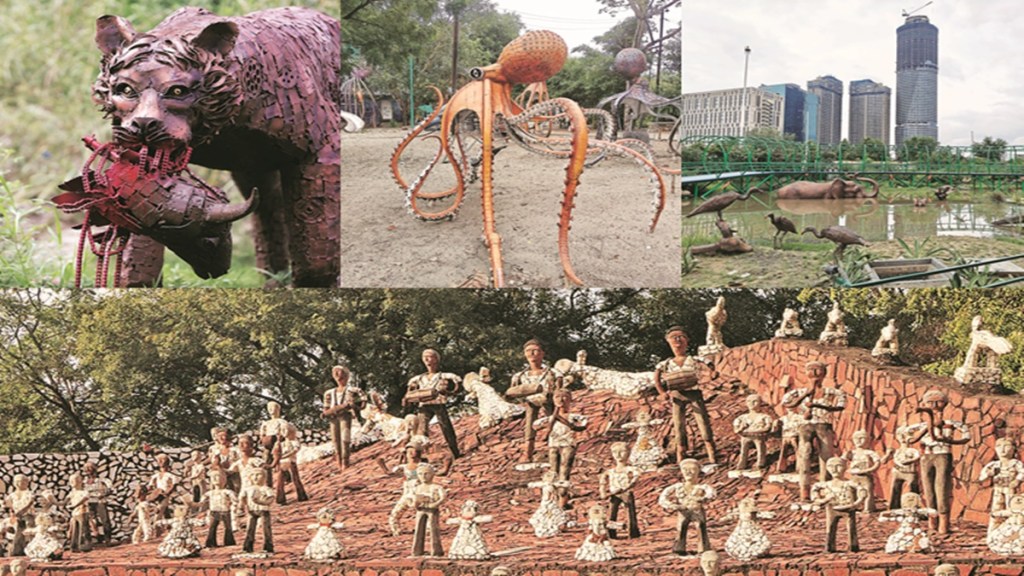A peacock flutters into the air, taking a short flight to its roosting perch. Next to it, a lion strides confidently across the grassland, its powerful frame silhouetted against the fading light, and a prey from a successful hunt clutched in its jaws. Not far away, an emu with a long, bare neck and sturdy legs stands watchfully by the path, alert to every movement. High above, chimpanzees swing through the trees with ease, using brachiation, their unique arm-swinging motion, to navigate the forest canopy with agility and grace.
This may look like a scene straight out of The Jungle Book, except that the birds and animals—totalling 582—in this idyllic narration are sculptures crafted from metal scrap like bicycle horns, chains, waste pipes, and iron rods. These waste-turned-wonders have now found a new home in Noida’s newest theme park— Jungle Trail.
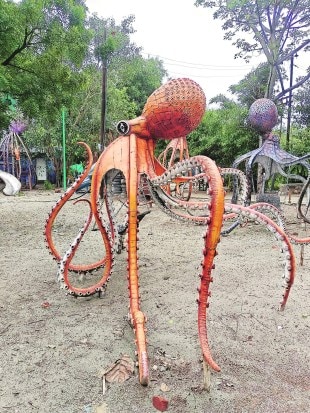
Not only has the park breathed new life into nearly 500 tonne of discarded industrial debris and metal waste— transforming them into life-sized installations that represent wildlife from six continents and four themed zones from across the world—but has also given local residents as well as tourists a new zone for events, adventure and entertainment.
The park is spread across 20 acres of land under the New Okhla Industrial Development Authority (Noida), which are mostly underutilised spaces near flyovers and green grasslands, and has been developed in collaboration with Z-Tech, a private firm under a public-private partnership (PPP) model at a cost of Rs 22 crore. The aim is to serve as a hub for sustainable tourism in Delhi-NCR.
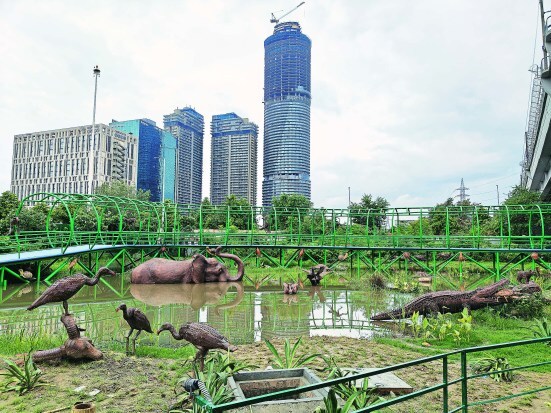
“We had an enormous pile of waste collected from the anti-encroachment drives over the years. The idea of transforming it into a wildlife park was both sustainable and imaginative. This way the tourists visiting the city will not only have the option of going to malls in Noida but also visit these innovative parks,” Anand Mohan Singh, director (horticulture), Noida Authority, tells FE.
Adding to this immersive getaway is the Night Safari, where the park lights up for a magical experience of the jungle under the stars. “All sculptures, gazebos, lights, benches, etc, inside the park are made from recycled materials,” says Isha Chaudhary, vice president, Z-Tech, a diversified engineering company specialising in sustainable solutions and theme park development.
Meanwhile, this year, Noida emerged as the cleanest city in the 3-10 lakh population category in the Swachh Survekshan 2024-25 awards, followed by Chandigarh and Mysore. “This achievement reflects Noida’s commitment to maintaining a clean and sustainable urban environment and has helped us achieve our ranking by gaining extra points,” adds Singh.
Noida may have become the first city in India to create a jungle-themed park but it is not the first to embrace the idea of ‘waste to wonder’. In 2019, Delhi’s Waste to Wonder Park near Sarai Kale Khan recreated iconic world monuments like the Taj Mahal and Eiffel Tower from 150 tonne of scrap sourced from automobile parts, iron sheets, fans, bicycles, and more. Even the washrooms in the park are made from repurposed shipping containers. The park, created by the Municipal Corporation of Delhi, has been estimated to make a revenue of Rs 1-1.5 crore every month, and is aimed to promote waste management and environmental awareness. It now features 40 dinosaur replicas made from scrap materials—a giant T-Rex built using old gas cylinders, pipes and bike chains; the Stegosaurus has tyres for its back plates and fan blades for its body.
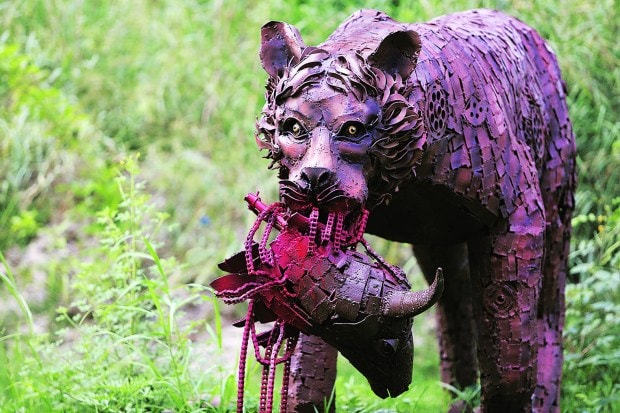
The waste-to-wonder concept is a growing movement to transform urban waste into artistic wonders. By turning trash into treasure, it offers aesthetic appeal while pushing sustainable urban development, aligning with the national goals of cleanliness, waste reduction, and smart city planning.
Metal marvels
Across the world, artists, architects, and city planners have been reimagining discarded materials as tools for storytelling, environmental education, and urban regeneration. Countries like Brazil, Kenya, and Thailand have embraced waste as a creative resource. Thailand’s Wat Pa Maha Chedi Kaew temple is built from over a million recycled beer bottles. Nairobi artists crafted animal sculptures from flip-flop pollution washed ashore, a community project by social enterprise, Ocean Sole, turning waste into cultural treasures, and also promoting recycling, public engagement, and community upliftment. Reports suggest that at least 8 million tonne of plastic enters the oceans every year. It is estimated that by 2050, there could be more plastic than fish in the seas by weight.
Back home, Delhi alone generates an estimated 200,000 tonne of e-waste annually, a staggering figure that includes a mix of metal scrap, circuit boards, wires, batteries, and obsolete electronics. Much of this waste comes from discarded appliances, defunct industrial equipment, and the growing mountain of consumer tech products. While this waste often ends up in informal recycling sectors, sometimes handled in unsafe conditions, projects like Waste to Wonder Parks and many scrap-art installations help change that narrative.
Delhi’s Shahidi Park honours freedom fighters with sculptures made from industrial chains and railway parts, such as a 20-foot-tall Bhagat Singh, built entirely from old railway tracks, engine parts and industrial chains. In Chanakyapuri, 22 sculptures made from scrap metal of animals and birds of the G20 member-countries stand in the waste-to-art park. A fierce lion made using old bicycle chains, iron rods, auto parts and pieces of rusted steel represents Great Britain, for instance.
Chandigarh’s famous Rock Garden showcases thousands of sculptures built from recycled materials like tiles, etc. In Lucknow, UP Darshan Park displays miniature monuments made of scrap, while a Waste to Wonder Musical Park near CG City Wetland uses bottles and tyres to create musical instruments.
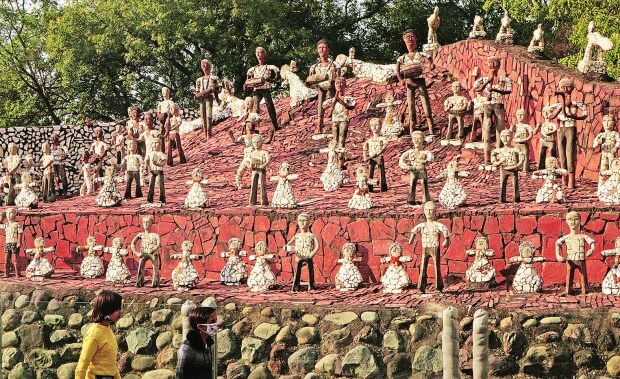
Even the Kempegowda Airport Halt Station has a mural inspired by a Yakshagana dancer, created from waste wooden mango crates and newspaper, depicting mudras and dance movements. At Bharat Mandapam in Delhi, there’s an 18-foot-tall and intricately detailed sculpture titled ‘Bhoo Devi’ created by artist Gopal Namjoshi, which embodies mother nature in metal flowers, leaves, spiders, and birds, all welded from scrap.
Another arresting sight is to watch over 2,000 sculptures, dressed in colourful costumes made from beads and broken glass bangles, that stand in line at the Rock Garden of Chandigarh, which has a 35-acre eco-friendly garden built solely from home waste and other industrial items such as bangles, ceramic pots, tiles, bottles and electric waste. While the garden brings a versatile mix of landscape, architecture, sculpture and mythology, starting in 1957, little did the creator and founder of this garden, Nek Chand, know that his creation could be an inspiration for a concept like waste to wonder in the future. For this reason, Chand has also received numerous awards such as Padma Shri (1984) and the Grande Médaille de Vermeil from the city of Paris in recognition of his artistic expression.
Conscious creativity
What’s discarded or labelled as useless has found creativity through the hands of many artists. Indore-based metal artist Deval Verma challenges the way people perceive waste, not as a problem but as potential. “India has always been a land of jugaad and mindful use but rapid urbanisation has distanced us from those values. The concept of ‘waste to wonder’ brings this back, not as nostalgia but as necessity. We’re living in a world of overconsumption and under-awareness. Waste is one of the biggest global challenges but the solutions don’t always have to be technical, they can be emotional. I find art as a powerful tool to bridge this gap,” says Verma, who has transformed industrial scrap into striking sculptures for over eight years. His philosophy is simple: “Taking trash and making treasure.”
Verma’s works include an 8-foot Hanuman statue in Gujarat, the BHARAT installation at the Constitution Museum in Sonipat, and a peacock sculpture at the Prime Minister’s residence. His art celebrates culture, spirituality, and environmental narratives.
Transforming industrial scrap, discarded tools, automotive parts, and other forms of waste into striking, large-scale sculptures, the mechanical engineer-cum-product designer has so far upcycled over 20 tonne of scrap into more than 200 sculptures, ranging from brand installations and wildlife forms to public artworks with deep cultural and environmental narratives.
His key works include Kargil Vijay Smarak, a 1,000-kg tribute to the Indian armed forces, celebrating valour and sacrifice; TAURUS, a 350-kg bull sculpture installed in Dubai, reflecting strength and power; KOI fish—featured for four consecutive years in the Legend Metal Calendar, Japan; representing India on a global metal art platform.
In India, especially, where population and waste generation are both high, the concept of ‘waste to wonder’ serves as an eye-opener to educate, inspire, and involve communities, turning public spaces into thought-provoking landscapes. “Countries like Japan and Sweden have institutionalised recycling and reuse. In India, the seeds are there, we just need to water them,” adds Verma, who shares Indore’s Cleanliness Drives as an example, where waste management became a civic movement.
Artists like Vibhor Sogani choose to engage with sustainability not only as a personal or creative act but as part of a broader conversation, creating awareness, evoke emotions, and generate momentum. Sogani is known for large-scale, site-responsive public installations that have become civic landmarks, such as Sprouts in New Delhi, Kalpavriksha in Ahmedabad, and his celebrated international works Deepam and Pool of Dreams at the Amsterdam Light Festival.
“Rethinking waste is not just important but urgent. The idea is essentially about shifting perception and recognising potential in what has been discarded and allowing materials to have more than one life,” says Sogani.
For Sogani, India, with its rich history of resourcefulness, is uniquely positioned to make significant contributions to this worldwide movement. He says, “It is not always easy but it is deeply rewarding when the outcome resonates both aesthetically and ethically. Globally, we’ve seen artists and institutions integrate sustainability into their core practices through the use of recycled materials, community engagement, and site-specific interventions that address environmental urgencies. While India has always had an ingrained culture of reuse and adaptation, it hasn’t always translated into our formal or public art spaces. That is beginning to shift but we still have work to do in terms of raising awareness, developing infrastructure, and establishing platforms that support such practices. Artists are now actively questioning why their work shouldn’t be as sustainable as alternatives in other industries,” adds Sogani, whose recent work titled Cosy Cocoon utilises industrial by-products to create a sculptural installation that invites reflection, both literally and metaphorically.
On the other hand, initiatives like the Hasiru Mane Project in Bengaluru supported by social enterprise, Hasiru Dala, is a shining example of repurposing waste for social good. After the devastating floods of 2017 that displaced many waste pickers, the initiative in collaboration with the Selco Foundation, helped build affordable homes using recycled materials such as fly ash bricks, scrap metal, and discarded fittings—blending sustainability with community resilience.
Small scrap dealer Devraj Gosai and his wife Jayabai, a waste picker, living in Kuntigram, Hebbal in Bengaluru, were the beneficiaries of this initiative, whose house was destroyed in floods. Today, their house has been redone using solar power and recycled materials like fly ash brick—made from fly ash, a byproduct of coal combustion, which helps reduce landfill waste; unused electrical fittings, discarded doors, sanitary fittings, pipes, wires, etc.
Nalini Shekar, co-founder and director, finance and special project, Hasiru Dala, says, “Waste to wonder as a concept promotes transforming discarded materials into valuable and beautiful creations, essentially turning waste into wealth. Gosai’s house is one example of repurposing materials. With so much scrap lying in the city, people like to upgrade their houses every 10 years using new materials. If this unused construction waste is collected properly it can be used in a diligent way. Many people in India still find it uncool to talk about using recycled material to build a house or space around. This needs to change.”
Waste not worthy
However, urban experts think differently. Suneel Pandey, senior fellow and director, environment & waste management division, The Energy and Resources Institute (TERI), highlights an important aspect that metals have high recycling value and can be recycled repeatedly. “Locking scrap metal into sculptures may reduce its potential to be recycled back into products. Artistic reuse is most justified when volumes are small or when materials are difficult to recycle otherwise,” he says, adding how metals are an exception.
According to Pandey, all metals have high recycling value and can be recycled a number of times, paper can be recycled any number of times. But recycling two wheel tyres is energy intensive.
“If there are only 10-15 tyres in a society, then creating artistic value makes sense. But for scrap material, it is wasting material value. Europe, Korea and now India are moving toward the decarbonisation process with focus on green steel as it can be replaced by conventional fuel and scrap can be mined, which can be converted into steel at a large scale.”
For Delhi-based urban designer professor KT Ravindran, former chairperson of the Delhi Urban Arts Commission (DUAC), such an activity is part of an urban design exercise and it should be coupled with a policy on public art and public space improvement and design.
“We should not see this concept in isolation but it should be treated as an activity generating a more liveable city. We need an important mind shift. Techniques of this kind of activity have been mastered across the world but to adapt to a city, and applied in 3D thinking and onto city level urban design, is an important component,” he says.
“In India, we cannot deal with waste leave alone turning into art. It’s an excellent idea provided we are able to collect and treat our waste. We have to create an asset. Think of its amenity that improves the living condition in the city rather than making money. We must run after quality of life,” adds Ravindran.

